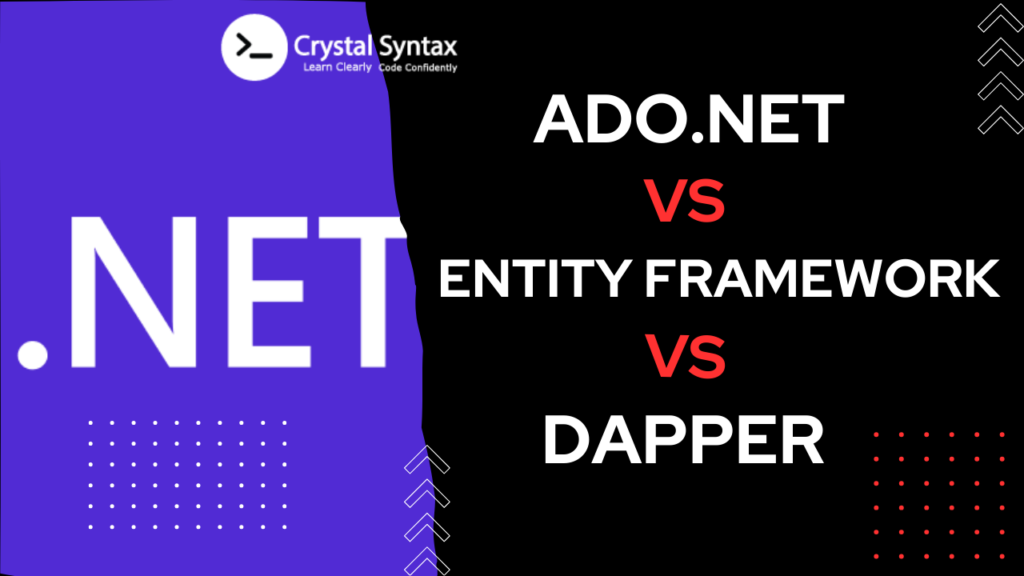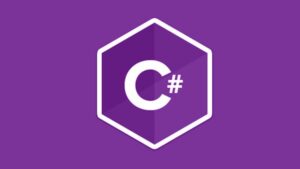These three technologies—ADO.NET, Entity Framework (EF), and Dapper—are commonly used to interact with relational databases in .NET applications. Each has different trade-offs in terms of performance, ease of use, maintainability, and flexibility. Let’s dive into their differences, examples, and when to use (or avoid) each.
1. ADO.NET: Overview
ADO.NET is a low-level data access API in .NET. It provides direct access to relational data through SQL queries or stored procedures, and requires developers to manually manage connections, commands, and result sets.
- When to Use: When you need maximum performance and complete control over database operations.
- When Not to Use: If you prefer abstraction and don’t want to deal with SQL queries directly.
Example: ADO.NET Query Execution
using (SqlConnection connection = new SqlConnection("your-connection-string"))
{
connection.Open();
string query = "SELECT * FROM Products WHERE Price > @Price";
using (SqlCommand command = new SqlCommand(query, connection))
{
command.Parameters.AddWithValue("@Price", 100);
using (SqlDataReader reader = command.ExecuteReader())
{
while (reader.Read())
{
Console.WriteLine(reader["Name"].ToString());
}
}
}
}Pros of ADO.NET:
- High Performance: No ORM overhead, making it the fastest option.
- Complete Control: Direct SQL execution with full control over queries.
- Good for Batch Operations: Works efficiently with large datasets.
Cons of ADO.NET:
- Boilerplate Code: Requires a lot of repetitive code for connection management and mapping.
- Error-Prone: Manually managing connections and result sets increases the chance of errors.
- Harder to Maintain: SQL logic spread throughout the codebase can become difficult to maintain.
2. Entity Framework (EF): Overview
Entity Framework (EF) is a full-fledged ORM (Object-Relational Mapper) that abstracts away database details by mapping database tables to .NET classes. It provides LINQ-based querying, handles relationships, and supports automatic change tracking.
- When to Use: When you want easy data management with minimal SQL.
- When Not to Use: If performance is a critical concern or you have complex queries.
Example: Query with Entity Framework
using (var context = new ApplicationDbContext())
{
var products = context.Products.Where(p => p.Price > 100).ToList();
foreach (var product in products)
{
Console.WriteLine(product.Name);
}
}Pros of Entity Framework:
- Easy to Use: Simplifies database access with LINQ queries.
- Change Tracking: Automatically tracks entity changes, making updates easier.
- Database-First & Code-First: Supports both database-first and code-first development.
- Handles Relationships: Manages relationships between entities automatically.
Cons of Entity Framework:
- Performance Overhead: Slower than ADO.NET or Dapper due to ORM overhead.
- Limited SQL Control: Not ideal for complex SQL queries or batch operations.
- Higher Memory Usage: Tracks entities in memory, which can increase resource consumption.
3. Dapper: Overview
Dapper is a micro-ORM that sits between ADO.NET and full-fledged ORMs like EF. It provides performance close to ADO.NET but simplifies the code by mapping query results to .NET objects automatically.
- When to Use: When you want high performance with minimal boilerplate code.
- When Not to Use: If you need automatic change tracking or entity relationships management.
Example: Query with Dapper
using (var connection = new SqlConnection("your-connection-string"))
{
var products = connection.Query<Product>("SELECT * FROM Products WHERE Price > @Price", new { Price = 100 });
foreach (var product in products)
{
Console.WriteLine(product.Name);
}
}Pros of Dapper:
- High Performance: Close to ADO.NET performance.
- Simple Code: Reduces boilerplate code by mapping query results to objects.
- Flexible: Allows full control over SQL queries.
- Lightweight: Does not have the overhead of a full ORM like EF.
Cons of Dapper:
- No Change Tracking: You need to manage state changes manually.
- Limited Relationship Handling: Does not support complex entity relationships as EF does.
- Manual Mapping for Complex Queries: Requires more work for multi-entity mapping.
Performance Comparison
| Operation | ADO.NET | Entity Framework | Dapper |
|---|---|---|---|
| Query Execution Speed | Fastest | Slowest | Faster than EF |
| Change Tracking | Manual | Automatic | Manual |
| Query Complexity Handling | Full Control | Limited | Full Control |
| Ease of Use | Hard | Easiest | Moderate |
| Batch Operations | Best | Inefficient | Good |
When to Use Which?
- ADO.NET:
- Use when performance is critical and you need fine-grained control over database operations.
- Suitable for high-performance batch operations, legacy systems, or large-scale applications.
- Entity Framework (EF):
- Use for CRUD-heavy applications where ease of development is more important than raw performance.
- Suitable for projects with many relationships and where you want to leverage change tracking.
- Dapper:
- Use when you need performance close to ADO.NET but with simpler code.
- Suitable for read-heavy applications or microservices where relationships are minimal.
Insert Operation with ADO.NET:
using (SqlConnection connection = new SqlConnection("your-connection-string"))
{
connection.Open();
var query = "INSERT INTO Products (Name, Price) VALUES (@Name, @Price)";
using (SqlCommand command = new SqlCommand(query, connection))
{
command.Parameters.AddWithValue("@Name", "New Product");
command.Parameters.AddWithValue("@Price", 200);
command.ExecuteNonQuery();
}
}Insert Operation with Entity Framework:
using (var context = new ApplicationDbContext())
{
context.Products.Add(new Product { Name = "New Product", Price = 200 });
context.SaveChanges();
}Insert Operation with Dapper:
using (var connection = new SqlConnection("your-connection-string"))
{
var query = "INSERT INTO Products (Name, Price) VALUES (@Name, @Price)";
connection.Execute(query, new { Name = "New Product", Price = 200 });
}Conclusion
- ADO.NET is best for high-performance, low-level database operations but requires more code and maintenance.
- Entity Framework is ideal for quick development and relationship management, but it has performance overhead.
- Dapper strikes a balance, offering performance close to ADO.NET with less boilerplate code, but lacks advanced ORM features like change tracking.
Choosing the right tool depends on the project’s requirements:
- For performance-critical applications: ADO.NET or Dapper.
- For ease of development and maintenance: Entity Framework.
- For a balance between performance and simplicity: Dapper.






